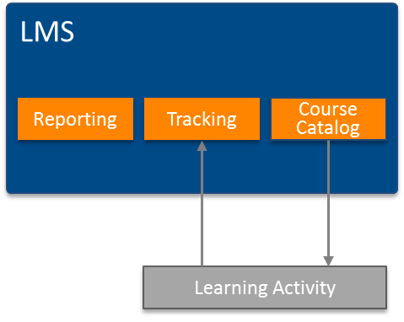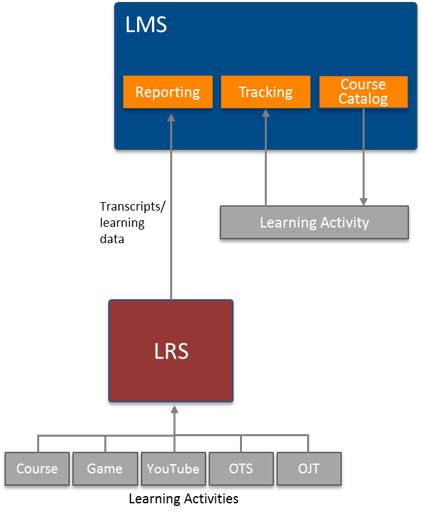Posted by Caveo Learning ● June 24, 2015
Tin Can API and the Age of Informal Learning
 Call it informal learning, experiential learning, social learning … whatever moniker you hang on it, there is a vast segment of skills and knowledge acquisition that has nothing to do with the learning and development organization.
Call it informal learning, experiential learning, social learning … whatever moniker you hang on it, there is a vast segment of skills and knowledge acquisition that has nothing to do with the learning and development organization.
Think about how you learn things—and it doesn’t really matter whether it’s professional or personal. Chances are, you watched something or someone showed you how to do it. In fact, the U.S. Bureau of Labor Statistics estimates that 70% of job knowledge is acquired via such informal learning.
These days, when someone has to fix a household appliance, they're likely to first visit YouTube for a demo video or ask for advice from friends on Facebook. With the exception of seismic shifts in process or technology, most people learn most of what they do in their jobs in much the same way.
Most people acquire knowledge and skills through on-the-job training or over-the-shoulder observation, whether their employers recognize it or not. What does this mean for learning leaders? The temptation for some is to try and control it, but that's both unreasonable and unwise.
We need to let learning happen, not make it happen. Informal learning isn’t a bad thing, it’s just a different way of achieving results than learning leaders are used to. The smarter move is what some organizations are already doing—embrace it and enable it—and that means having some idea of what is happening with learners and measuring those activities.
Why have we been measuring learning by courses completed and other events pushed out to learners and checked off a list? In large part, it's because the technology to do otherwise hasn’t existed until now.
Enabling the LMS to Do More
Implementing a learning management system has become de rigeur as a necessity to compete for and retain top talent. And what does the typical LMS implementation do? It serves up elearning courseware and tracks results. That's why the fine folks who brought you the SCORM standard have taken the next step and developed a new protocol for collecting learning-related activities outside traditional LMS capabilities.
Project Tin Can (named to reflect the rudimentary two-way conversation device) has produced an application program interface (API), also known as the Experience API (xAPI), that captures learning data in streams of “actor/verb/object” and stores them in a repository. That repository can be accessed by an LMS or reporting tool.
In laymen's terms, Tin Can API enables organizations to keep track of an individual’s learning activities beyond LMS-land. That “actor/verb/object” phrase? Think of an individual who says “I/did/this.” It extends the LMS into real-world activities that constitute something closer to real learning, as compared to classroom training or eLearning.
When someone goes to a seminar at a conference, picks up continuing education credits, presents a paper, uses a new piece of equipment, or pretty much anything else that can be captured in that “actor/verb/object” expression, it can be recorded. Call it a learning record. And the place where you keep the learning records is the Learning Record Store (LRS). That LRS can live within or alongside an LMS or someplace else.
Also, consider the power of capturing learning activities generated from a social learning platform, like Yammer or Google Hangouts. Capturing activities from communities of practice or virtual collaborations would offer a more well-rounded view of an individual’s true knowledge and skill set. That presents some huge possibilities for competency and performance management.
How Does Tin Can API Work?
If we view the way things work today in the LMS-centric world, the activity looks a lot like the chart below:

Courses or other material are served centrally, and learning activity is communicated back for tracking and reporting purposes. Add the LRS into the picture, and the architecture looks like this:

Other learning activities can now be tracked, regardless of where they originate. Learners can log their activities directly into the LRS, which can transmit that information to the LMS (or someplace else, if it makes more sense) for reporting. Notice the directional flow of the arrows in the LRS stream; the activity is learner-initiated and outside the control of the LMS. That’s another way of saying learners have a greater hand in managing what and how they learn.
This is a bit oversimplified, but it serves the purpose of comparison. The architectures can be much more sophisticated than this and can include, for example, mobile apps for logging activities.
Tin Can API in Action
So far, the companies adopting the standard have largely been learning technology vendors like Articulate, Adobe, Blackboard, Moodle, Sakai, and dozens of others. Adoption among non-learning product and service organizations is a different story. However, some companies have dipped a toe in the water and are experimenting with ways to integrate Tin Can API technology into their learning platforms.
AT&T is piloting a new way of handling compliance training among nearly a quarter million employees with about 4,000 job titles. Although the content ostensibly addresses ethics and compliance, the real experiment centers on determining whether a video-based simulation caused the same amount of retention as text-based simulation. In addition to showing statistically how much more effective the video version was, AT&T came away with great insight into how employees would behave in a challenging ethical situation. This goes beyond mere check-it-off-the-list compliance training and gives AT&T empirical data demonstrating that employees almost always make the tough choice, even when they think it is the wrong choice. “Tin Can helped us use a scientifically valid approach to measure numerically, and prove the existing high level of our employees' ethical behavior,” Lead Training Manager Larla Bogle explained. “Every project now that I work on, I’m thinking about what learner actions and outcomes Tin Can can show me that I couldn’t have known before.”
There also was a surprise benefit. “If someone said they had a problem [with the simulation], we could immediately identify where they clicked and exactly where they were stuck,” Bogle says. This presents an opportunity to correct flaws with the content. “We very quickly identified that all of the people who were having a technical issue were using a specific browser.” That helped de-focus on the content since there wasn’t an issue to fix.
There are some technology implications and complexities wrapped up in all of this, and it’s not cheap, either. But for the organizations that make the investment of time, dollars, and resources, the benefits are not hard to imagine. Along with a fuller view of talent and capabilities comes insights into which activities help deliver business value (e.g., increased sales), which activities lead to a better customer experience, and so forth. Couple that, for example, with badges for activities shown to be effective, and you have a motivator for learning useful things.
All of this means that learning leaders can stop concerning ourselves with where and how people learn, and focus instead on helping them teach themselves. They’ve been doing it all along anyway.
Topics: Learning Trends, eLearning
